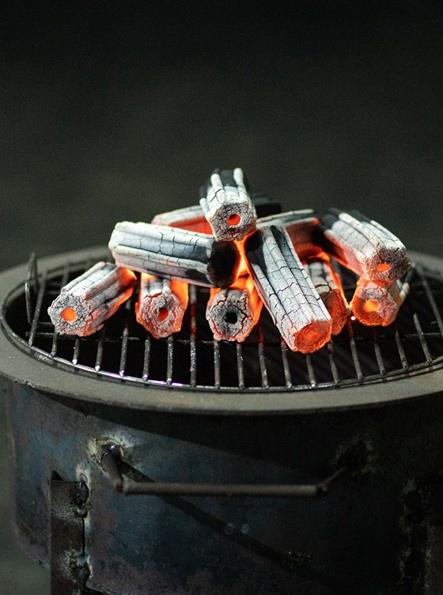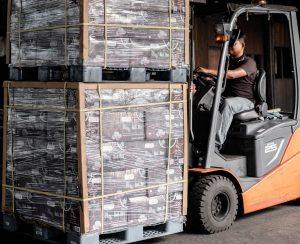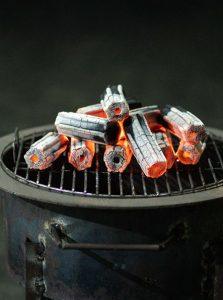Grilling is an experience. Whether you’re searing steaks, smoking ribs, or grilling veggies, the type of charcoal you use can make or break your results. While many grillers focus on charcoal type—lump vs. briquettes—fewer consider how the shape of the charcoal impacts heat distribution, burn time, and even flavor.
The shape of your charcoal directly affects:
- Heat control: Some shapes burn hotter and faster, while others provide steady, even heat.
- Burn time: The right shape can mean fewer refuels and a longer grilling session.
- Flavor profile: Certain shapes burn cleaner, producing less ash and a purer smoky flavor.
- Ease of use: Depending on your grill type and cooking method, some shapes are more convenient than others.
In this guide, we’ll break down the best charcoal shapes for grilling, comparing their performance, efficiency, and impact on flavor. Whether you’re using a kettle grill, a smoker, or a hibachi, choosing the right shape can elevate your BBQ game.
What is the Best Charcoal Shape for Grilling?
Charcoal comes in a variety of shapes, each designed to optimize heat output, burn duration, and usability. The three most common types of charcoal shapes are:
1. Lump Charcoal
Lump charcoal consists of natural, irregularly shaped chunks of charred hardwood. It’s favored by many grillers for its pure composition and ability to burn hot and fast.
Pros:
- Lights quickly and reaches high temperatures fast.
- Produces minimal ash, making cleanup easier.
- Burns clean with a natural, smoky flavor.
Cons:
- Irregular shape leads to inconsistent heat distribution.
- Shorter burn time compared to briquettes, requiring frequent refueling.
- More expensive than other charcoal types.
2. Charcoal Briquettes
Briquettes are uniform, pillow-shaped charcoal pieces made from compressed charcoal dust, additives, and binders. They’re known for their consistent burn and steady heat output.
Pros:
- Burns evenly and maintains a steady temperature.
- Longer burn time, making it ideal for slow-cooking.
- More affordable and widely available.
Cons:
- Takes longer to ignite compared to lump charcoal.
- Produces more ash, requiring frequent grill cleaning.
- Some brands contain chemical binders that can impact flavor.
3. Pellet Charcoal
Charcoal pellets are compressed hardwood sawdust pieces designed for use in pellet grills. They offer precise temperature control and are ideal for low-and-slow smoking.
Pros:
- Provides consistent, even heat with precise control.
- Offers a variety of wood flavors for enhanced taste.
- Minimal ash production.
Cons:
- Requires a pellet grill, limiting versatility.
- Burns faster than briquettes, needing constant feeding.
- Not as hot as lump charcoal, which can affect searing ability.
How Shape Affects Grilling Performance
The shape of your charcoal influences several key grilling factors:
- Heat distribution: Lump charcoal’s irregular pieces create hot and cool zones, while briquettes provide even heat.
- Burn time: Briquettes last longer than lump charcoal, making them ideal for extended cooking.
- Ease of use: Lump charcoal is unpredictable, while briquettes and pellets offer greater control.
Choosing the right charcoal shape depends on your cooking style, grill type, and flavor preferences. In the next section, we’ll explore the specific factors to consider when selecting the best charcoal shape for your grilling needs.
Factors to Consider When Choosing Charcoal Shape
Selecting the best charcoal shape isn’t just about preference—it directly impacts your grilling experience. Here are the key factors to consider:
1. Heat Distribution
The shape of charcoal affects how evenly heat spreads across the grill.
- Lump charcoal burns at varying temperatures due to its irregular shape, creating hot and cool spots—great for searing and two-zone cooking.
- Briquettes provide consistent heat due to their uniform shape, making them ideal for even cooking and long grilling sessions.
- Pellets burn steadily in pellet grills, offering precise heat control but requiring a specialized grill.
🔹 Best for: Balanced heat control – Briquettes
2. Burn Time
If you plan to grill for extended periods, burn time is crucial.
- Briquettes burn the longest due to their compressed composition.
- Lump charcoal burns hotter but faster, requiring frequent refueling.
- Pellets burn efficiently but require a constant feed in a pellet grill.
🔹 Best for: Long cook times – Briquettes
3. Ease of Use
Different charcoal shapes offer varying levels of convenience when lighting and managing the grill.
- Lump charcoal lights quickly but requires monitoring for temperature control.
- Briquettes take longer to ignite but provide a steady, manageable heat level.
- Pellets are the easiest to use, thanks to automated pellet grills, but require electricity.
🔹 Best for: Set-it-and-forget-it grilling – Pellets
4. Flavor Considerations
The smoke from charcoal influences the taste of grilled food.
- Lump charcoal offers a natural, clean-burning smoke with an authentic wood-fired flavor.
- Briquettes can contain additives that may affect taste but provide a steady burn.
- Pellets come in different wood flavors (e.g., hickory, mesquite) for precise taste control.
🔹 Best for: Pure smoky flavor – Lump Charcoal
5. Grill Type Compatibility
Different grills work best with specific charcoal shapes:
| Grill Type | Best Charcoal Shape |
| Kettle Grills | Briquettes or Lump |
| Smokers | Briquettes or Pellets |
| Kamado Grills | Lump Charcoal |
| Pellet Grills | Pellet Charcoal |
| Portable Grills | Briquettes or Lump |
Understanding these factors will help you pick the right charcoal shape for your grilling style. Next, we’ll compare lump charcoal and briquettes to determine which is best for grilling.
Read: How Charcoal Affects Shisha Flavor: Choosing the Best Option
Lump Charcoal vs. Briquettes: Which is Better for Grilling?
The debate between lump charcoal and briquettes has been ongoing for years, with each having distinct advantages and drawbacks. Understanding their differences can help you decide which suits your grilling needs best.
1. Heat and Temperature Control
- Lump charcoal burns hotter, often reaching 1,000°F (537°C) or more, making it perfect for searing steaks and fast grilling.
- Briquettes burn at a lower, steady temperature (around 600-700°F or 315-370°C), which is ideal for slow-cooking and maintaining consistent heat.
- Best for high-heat grilling: Lump charcoal
- Best for low-and-slow BBQ: Briquettes
2. Burn Time and Efficiency
- Briquettes burn longer due to their dense composition, making them more efficient for long smoking sessions.
- Lump charcoal burns out faster but offers a more natural burn.
- Best for long cooks (ribs, brisket): Briquettes
- Best for quick grilling (steaks, burgers): Lump charcoal
3. Ash Production and Cleanup
- Lump charcoal produces less ash, making cleanup easier.
- Briquettes leave behind more ash, requiring frequent disposal.
- Best for easy cleanup: Lump charcoal
4. Flavor Impact
- Lump charcoal is all-natural and burns cleanly, imparting a pure, smoky wood flavor to food.
- Briquettes sometimes contain binders or fillers that can affect taste but provide consistent burning.
- Best for authentic smoky flavor: Lump charcoal
5. Cost and Availability
- Briquettes are widely available and cheaper.
- Lump charcoal is more expensive but provides a natural grilling experience.
- Best for affordability: Briquettes
- Best for premium grilling: Lump charcoal
Quick Comparison Table
| Feature | Lump Charcoal | Briquettes |
| Burn Temperature | 🔥🔥🔥 (Very Hot) | 🔥🔥 (Moderate) |
| Burn Time | ⏳ Shorter | ⏳⏳ Longer |
| Ash Production | ✅ Low | ❌ Higher |
| Flavor | 🌿 Natural, Smoky | 🏭 Possible Additives |
| Cost | 💰 More Expensive | 💲 Affordable |
| Best For | Searing, High Heat | Slow Cooking, Consistency |
Verdict: Which Should You Choose?
- If you want quick, high-heat cooking with a pure smoky flavor, go for lump charcoal.
- If you prefer long, consistent burns and affordability, briquettes are the better choice.
Both charcoal types have their place in grilling, depending on what and how you’re cooking. In the next section, we’ll explore innovative charcoal shapes that can further enhance your grilling experience.
Innovative Charcoal Shapes for Grilling
While lump charcoal and traditional briquettes dominate the market, innovative charcoal shapes are gaining popularity. These designs enhance grilling performance by improving heat control, burn efficiency, and ease of use. Let’s explore some unique charcoal shapes and their benefits.
1. Hexagonal Briquettes
Hexagonal briquettes are densely compressed, tube-shaped charcoal pieces with a hole in the center. Originally popular in Asian grilling, they are now favored by BBQ enthusiasts worldwide.
Pros:
- Burns longer than standard briquettes.
- Hollow center improves airflow, ensuring consistent heat.
- Low ash production, making cleanup easier.
Cons:
- More expensive than regular briquettes.
- May take longer to ignite without a chimney starter.
Best for: Long, even burns—great for slow cooking and smoking.
2. Pillow-Shaped Briquettes
These are the most common briquettes found in stores, shaped like small cushions. They are made from charcoal dust, binders, and additives for even burning.
Pros:
- Affordable and widely available.
- Provides steady, predictable heat.
- Ideal for beginners due to ease of use.
Cons:
- Produces more ash than lump charcoal.
- May contain chemical additives.
Best for: Everyday grilling with consistent heat.
3. Coconut Shell Charcoal
Made from compressed coconut shells, this eco-friendly alternative is popular in Asian BBQ and hookah use. It burns cleaner and hotter than many other charcoals.
Pros:
- Environmentally friendly and sustainable.
- Burns hotter and longer than standard briquettes.
- Minimal ash and neutral smoke flavor.
Cons:
- More expensive and less available in some regions.
- Can take longer to ignite without a strong heat source.
Best for: Eco-conscious grillers who want a cleaner burn.
4. Binchotan Charcoal
A premium Japanese charcoal made from hardwood, binchotan is known for its ultra-long burn time and near-smokeless performance.
Pros:
- Can burn for 3-5 hours with consistent heat.
- Produces very little smoke and ash.
- Ideal for yakitori, hibachi, and high-end grilling.
Cons:
- Extremely expensive.
- Requires a longer ignition process.
Best for: High-end grilling and traditional Japanese BBQ.
5. Charcoal Pellets
Designed for pellet grills, these small, cylindrical charcoal pieces are compressed hardwood sawdust with no additives. They provide precision temperature control and a variety of smoke flavors.
Pros:
- Easy to use with pellet grills.
- Burns clean with minimal ash.
- Offers different wood flavors for enhanced taste.
Cons:
- Requires a pellet grill, limiting versatility.
- Needs a continuous fuel supply.
Best for: Pellet grill users who want effortless temperature control.
Choosing the Right Charcoal Shape for Your Needs
Each charcoal shape has its advantages, and your choice depends on your grilling style and priorities:
- For low-and-slow BBQ: Hexagonal briquettes or coconut shell charcoal
- For high-heat searing: Binchotan or lump charcoal
- For consistent, hassle-free grilling: Pillow briquettes
- For an eco-friendly option: Coconut shell charcoal
- For precision temperature control: Charcoal pellets
In the next section, we’ll break down how to choose the right charcoal shape for your specific grill to maximize performance.
How to Choose the Right Charcoal Shape for Your Grill
The type of charcoal you use should match your grill and cooking style. Certain charcoal shapes perform better in specific grill types, ensuring optimal heat control, efficiency, and flavor. Here’s how to make the right choice based on your grill.
1. Kettle Grills
Kettle grills, such as the classic Weber, require charcoal that provides consistent heat and easy control.
Best Charcoal Shapes:
- Briquettes for steady heat and long cooking times.
- Lump charcoal for higher temperatures and more flavor.
Why? Briquettes provide even, controlled heat, making them great for slow cooking. Lump charcoal burns hotter, perfect for searing burgers and steaks.
2. Smokers (Offset, Kamado, and Barrel Smokers)
Smoking requires charcoal that burns slowly at a low, consistent temperature.
Best Charcoal Shapes:
- Briquettes for long, even burns.
- Hexagonal briquettes for better airflow and longer cooking sessions.
- Coconut shell charcoal for a cleaner burn with less ash.
Why? Briquettes and hexagonal briquettes burn longer, reducing the need for frequent refueling. Coconut shell charcoal burns cleanly, which is great for long smoking sessions without overwhelming flavors.
3. Kamado Grills (Big Green Egg, Kamado Joe)
Kamado grills rely on thick ceramic walls to retain heat, meaning the charcoal must support extended cooking.
Best Charcoal Shapes:
- Lump charcoal for high heat and pure smoky flavor.
- Binchotan charcoal for a long, slow burn.
Why? Lump charcoal burns hot and clean, making it ideal for Kamado-style grilling. Binchotan charcoal can last for hours, allowing for efficient temperature control.
4. Pellet Grills
Pellet grills are designed for automated feeding and precise temperature control, requiring specialized fuel.
Best Charcoal Shapes:
- Charcoal pellets specifically made for pellet grills.
Why? Pellet grills only work with pellets, providing consistent heat and a range of wood flavors.
5. Portable Grills (Tabletop, Hibachi, Camping Grills)
Portable grills need charcoal that lights quickly and burns efficiently.
Best Charcoal Shapes:
- Lump charcoal for quick, high-heat grilling.
- Coconut shell charcoal for eco-friendly, clean burning.
Why? Lump charcoal lights fast and burns hot, making it ideal for short grilling sessions. Coconut shell charcoal burns cleaner, reducing excess smoke when grilling in small spaces.
Quick Charcoal Selection Guide by Grill Type
| Grill Type | Best Charcoal Shape |
| Kettle Grill | Briquettes, Lump Charcoal |
| Smoker | Briquettes, Hexagonal Briquettes |
| Kamado Grill | Lump Charcoal, Binchotan |
| Pellet Grill | Charcoal Pellets |
| Portable Grill | Lump Charcoal, Coconut Charcoal |
Final Tip: Match Your Cooking Style
- For high-heat grilling (searing): Lump charcoal, Binchotan
- For long smoking sessions: Briquettes, Hexagonal Briquettes
- For balanced grilling and affordability: Standard Briquettes
- For eco-conscious grilling: Coconut shell charcoal
Tips for Getting the Best Grill Results with Your Charcoal
No matter which charcoal shape you choose, proper handling and management can make a huge difference in your grilling experience. Follow these expert tips to maximize heat efficiency, burn time, and flavor.
1. Proper Charcoal Storage
Charcoal absorbs moisture, which can make it difficult to light and reduce its efficiency.
Best Practices:
- Store charcoal in a dry, airtight container or a sealed bag.
- Keep it in a cool, dry place to prevent humidity from affecting ignition.
- Avoid storing charcoal near chemicals or strong odors, as it can absorb unwanted smells.
2. Lighting Your Charcoal Efficiently
Avoid using lighter fluid, as it can leave behind unwanted flavors. Instead, use these safer and more effective methods:
- Chimney Starter: Fill a metal chimney starter with charcoal, place a fire starter or crumpled newspaper underneath, and light it. Within 10–15 minutes, your coals will be glowing hot.
- Electric Charcoal Starter: A plug-in heating element can ignite your charcoal in 5–10 minutes without any chemicals.
- Natural Fire Starters: Wax-coated wood shavings or paraffin cubes provide an odorless, chemical-free way to start your fire.
3. Managing Heat and Airflow
Control over airflow is key to maintaining consistent temperatures during grilling.
- More oxygen = higher heat: Open vents fully for searing and high-heat cooking.
- Less oxygen = lower heat: Close vents partially for slow cooking or smoking.
- Arrange coals strategically:
- Direct heat: Spread charcoal evenly for quick searing.
- Indirect heat: Push coals to one side for slow, controlled cooking.
4. Extending Burn Time
To get the most out of your charcoal, follow these simple techniques:
- Use briquettes or hexagonal briquettes for long cooking sessions.
- Add unlit charcoal to a burning batch (known as the “Minion Method”) to extend the burn gradually.
- For Kamado grills, arrange lump charcoal in a volcano shape to allow for steady, long-lasting combustion.
5. Enhancing Flavor with Wood Chips
Want an extra layer of smoky flavor? Try adding wood chips or chunks to your charcoal.
- Best wood pairings:
- Hickory: Bold, smoky flavor (great for ribs and pork).
- Mesquite: Strong, earthy smoke (ideal for beef).
- Apple/Cherry: Sweet, mild smoke (perfect for poultry and fish).
Soak wood chips in water for 30 minutes before use to prevent them from burning too quickly.
6. Cleaning and Reusing Charcoal
- Remove ash after each cook to maintain proper airflow.
- Partially burned lump charcoal can be reused—simply shake off the ash and store it for your next session.
- Invest in a grill grate cleaner to remove grease buildup, which can affect the flavor of your food.
Final Thoughts
Proper charcoal management can elevate your grilling experience, making your fire hotter, longer-lasting, and more flavorful. Whether you’re smoking brisket for 12 hours or quickly grilling burgers, these tips will help you get the best results every time.
In the final section, we’ll summarize the key takeaways and help you decide on the best charcoal shape for your grilling needs.
Conclusion: Choosing the Best Charcoal Shape for Your Grill
Selecting the right charcoal shape can make a significant difference in your grilling results. Whether you’re looking for high-heat searing, long burn times, or consistent temperature control, each charcoal shape has its strengths.
Key Takeaways:
- For high-heat grilling and pure smoky flavor, go with lump charcoal.
- For steady, long-lasting heat, briquettes are the best option.
- For efficient airflow and extended burns, hexagonal briquettes offer an upgrade.
- For an eco-friendly choice, coconut shell charcoal provides clean burning with minimal ash.
- For precise temperature control in pellet grills, charcoal pellets are the only choice.
Final Recommendation
If you’re a casual griller who enjoys consistency, briquettes are a reliable choice. For BBQ enthusiasts and flavor chasers, lump charcoal or specialty options like binchotan offer premium performance.
Regardless of your choice, managing your charcoal properly—from storage to lighting and airflow control—will help you achieve better, tastier, and more efficient grilling.
Now that you know the best charcoal shapes for grilling, it’s time to fire up your grill and put this knowledge to the test. Happy grilling!




